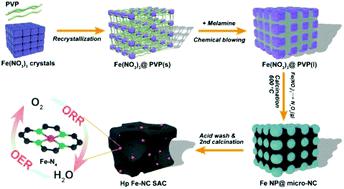当前位置:
X-MOL 学术
›
J. Mater. Chem. A
›
论文详情
Our official English website, www.x-mol.net, welcomes your
feedback! (Note: you will need to create a separate account there.)
A new strategy for engineering a hierarchical porous carbon-anchored Fe single-atom electrocatalyst and the insights into its bifunctional catalysis for flexible rechargeable Zn–air batteries
Journal of Materials Chemistry A ( IF 10.7 ) Pub Date : 2020-05-01 , DOI: 10.1039/d0ta03457f Cheng Du 1, 2, 3, 4, 5 , Yijing Gao 6, 7, 8, 9, 10 , Jianguo Wang 6, 7, 8, 9, 10 , Wei Chen 1, 2, 3, 4, 5
Journal of Materials Chemistry A ( IF 10.7 ) Pub Date : 2020-05-01 , DOI: 10.1039/d0ta03457f Cheng Du 1, 2, 3, 4, 5 , Yijing Gao 6, 7, 8, 9, 10 , Jianguo Wang 6, 7, 8, 9, 10 , Wei Chen 1, 2, 3, 4, 5
Affiliation

|
Single-atom catalysts (SACs) provide the most efficient metal utilization for various catalytic reactions. Meanwhile, hierarchical pore structures play a decisive role in determining the catalytic activity of N-doped porous carbon materials, since normally micropores provide active locations and macro/mesopores serve as mass transport channels. However, it remains challenging to engineer highly dispersed SACs with hierarchical pore structures due to the complexity in synthesizing extra templates with controlled sizes and the possible exogenous impurities from templates. Herein, we develop a facile “confined recrystallization” self-template strategy to synthesize a hierarchical porous Fe SAC on N-doped carbon (Fe-NC SAC) with an iron mass loading of 1.5 wt%, by using polyvinylpyrrolidone (PVP), ferric nitrate and melamine. In this novel strategy, the introduced PVP can restrict the recrystallization of ferric nitrate owing to its large molecular weight. The formed nano-sized ferric nitrate crystals can not only serve as multifunctional self-templates to produce hierarchical pores, but also form atomically dispersed Fe–Nx sites through getting nitrogen from melamine. With the Fe-NC SAC as the catalyst, an excellent bifunctional ORR/OER performance and long-term durability superior to those of Pt/C and RuO2 are achieved in both liquid and solid Zn–air battery tests. Notably, in the flexible solid Zn–air battery, the Fe-NC SAC showed a high discharge voltage of 1.25 V and stable charge–discharge cycling at 1 mA cm−2 under different bending conditions. Further density functional theory (DFT) calculations showed that the ORR follows the association mechanism of O2 → *OOH → *O → *OH → OH−, while the OER goes on through the mechanism of OH− → *OH− → *O → *OOH → O2, with a low theoretical overpotential of 1.21 V on the Fe-NC SAC. This work not only provides a novel strategy to endow SACs with a hierarchical pore structure, but also represents an example of how to effectively investigate the correlation between the structure and catalytic activity of catalysts.
中文翻译:

一种设计分层多孔碳锚定铁单原子电催化剂的新策略及其对柔性可充电锌空气电池双功能催化的见解
单原子催化剂(SAC)为各种催化反应提供了最有效的金属利用率。同时,分级的孔结构在确定N掺杂的多孔碳材料的催化活性中起决定性的作用,因为通常微孔提供活性位置,大孔/中孔充当传质通道。然而,由于合成具有受控大小的额外模板的复杂性以及模板中可能存在的外来杂质,设计具有分层孔结构的高度分散的SAC仍然具有挑战性。本文中,我们开发了一种简便的“密闭重结晶”自模板策略,该方法通过使用聚乙烯吡咯烷酮(PVP),三价铁在N掺杂碳(Fe-NC SAC)上合成铁含量为1.5 wt%的分层多孔Fe SAC。硝酸盐和三聚氰胺。在这种新颖的策略中 引入的PVP由于分子量大,可以限制硝酸铁的重结晶。形成的纳米硝酸铁晶体不仅可以用作多功能的自模板,以产生分层的孔,而且可以形成原子分散的Fe–N通过从三聚氰胺中获取氮而获得x个位点。使用Fe-NC SAC作为催化剂,在液体和固体Zn-空气电池测试中均获得了优于Pt / C和RuO 2的出色的双功能ORR / OER性能以及长期耐久性。值得注意的是,在柔性固态Zn-空气电池中,Fe-NC SAC在不同的弯曲条件下显示出1.25 V的高放电电压,并且在1 mA cm -2的条件下具有稳定的充放电循环。此外密度泛函理论(DFT)计算表明,ORR如下的O-联动机构2 →* OOH→* O→* OH→OH - ,而OER通过OH的机制推移- →* OH - →*○ →* OOH→O 2,在Fe-NC SAC上具有1.21 V的低理论过电位。这项工作不仅为赋予SAC具有分级的孔结构提供了一种新颖的策略,而且还代表了如何有效研究催化剂的结构与催化活性之间关系的一个实例。
更新日期:2020-05-01
中文翻译:

一种设计分层多孔碳锚定铁单原子电催化剂的新策略及其对柔性可充电锌空气电池双功能催化的见解
单原子催化剂(SAC)为各种催化反应提供了最有效的金属利用率。同时,分级的孔结构在确定N掺杂的多孔碳材料的催化活性中起决定性的作用,因为通常微孔提供活性位置,大孔/中孔充当传质通道。然而,由于合成具有受控大小的额外模板的复杂性以及模板中可能存在的外来杂质,设计具有分层孔结构的高度分散的SAC仍然具有挑战性。本文中,我们开发了一种简便的“密闭重结晶”自模板策略,该方法通过使用聚乙烯吡咯烷酮(PVP),三价铁在N掺杂碳(Fe-NC SAC)上合成铁含量为1.5 wt%的分层多孔Fe SAC。硝酸盐和三聚氰胺。在这种新颖的策略中 引入的PVP由于分子量大,可以限制硝酸铁的重结晶。形成的纳米硝酸铁晶体不仅可以用作多功能的自模板,以产生分层的孔,而且可以形成原子分散的Fe–N通过从三聚氰胺中获取氮而获得x个位点。使用Fe-NC SAC作为催化剂,在液体和固体Zn-空气电池测试中均获得了优于Pt / C和RuO 2的出色的双功能ORR / OER性能以及长期耐久性。值得注意的是,在柔性固态Zn-空气电池中,Fe-NC SAC在不同的弯曲条件下显示出1.25 V的高放电电压,并且在1 mA cm -2的条件下具有稳定的充放电循环。此外密度泛函理论(DFT)计算表明,ORR如下的O-联动机构2 →* OOH→* O→* OH→OH - ,而OER通过OH的机制推移- →* OH - →*○ →* OOH→O 2,在Fe-NC SAC上具有1.21 V的低理论过电位。这项工作不仅为赋予SAC具有分级的孔结构提供了一种新颖的策略,而且还代表了如何有效研究催化剂的结构与催化活性之间关系的一个实例。































 京公网安备 11010802027423号
京公网安备 11010802027423号